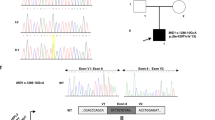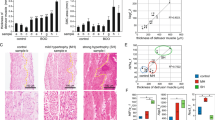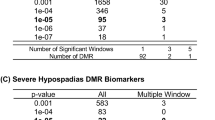Abstract
Hypospadias is a common congenital malformation in boys in which the urethral meatus opens on the underside of the penis. It is considered a complex disorder with several genes involved and the molecular etiology is just beginning to be revealed. As more than 85% of Opitz G/BBB syndrome (OS) patients with MID1 mutations are manifested with hypospadias, we have investigated the association between the MID1 gene and hypospadias. DNA from 114 hypospadias cases was analyzed with direct sequencing of the MID1 gene. Genotyping analysis was performed for the single-nucleotide polymorphism (SNP) c.1230G>A in 370 individuals with varying degrees of hypospadias and compared with 759 healthy controls. We identified one nonsense mutation c.712G>T (p.E238X), one missense mutation c.1679A>G (p.K560R) and two synonymous variants c.1230G>A (p.S410S) and c.1284T>G (p.V428V). We also detected a significant difference in the rare allele frequency of SNP c.1230G>A in hypospadias patients as compared with controls (P=0.016). Our finding suggests that hypospadias associated with hypertelorism is the mildest phenotype in OS caused by MID1 mutations.
Similar content being viewed by others
Log in or create a free account to read this content
Gain free access to this article, as well as selected content from this journal and more on nature.com
or
References
Källén, B. & Winberg, J. An epidemiological study of hypospadias in Sweden. Acta Paediatr Scand Suppl. 293, 1–21 (1982).
Paulozzi, L. J. International trends in rates of hypospadias and cryptorchidism. Environ Health Perspect. 107, 297–302 (1999).
Pierik, F. H., Burdorf, A., Nijman, J. M., de Muinck Keizer-Schrama, S. M., Juttmann, R. E. & Weber, R. F. A high hypospadias rate in The Netherlands. Hum Reprod. 17, 1112–1115 (2002).
Nelson, C. P., Park, J. M., Wan, J., Bloom, D. A., Dunn, R. L. & Wei, J. T. The increasing incidence of congenital penile anomalies in the United States. J Urol. 174, 1573–1576 (2005).
Fukami, M., Wada, Y., Miyabayashi, K., Nishino, I., Hasegawa, T., Nordenskjöld, A. et al. CXorf6 is a causative gene for hypospadias. Nat Genet. 38, 1369–1371 (2006).
Beleza-Meireles, A., Töhönen, V., Söderhäll, C., Schwentner, C., Radmayr, C., Kockum, I. & Nordenskjöld, A. Activating transcription factor 3: a hormone responsive gene in the etiology of hypospadias. Eur J Endocrinol. 158, 729–739 (2008).
Baskin, L. S., Erol, A., Jegatheesan, P., Li, Y., Liu, W. & Cunha, G. R. Urethral seam formation and hypospadias. Cell Tissue Res. 305, 379–387 (2001).
Opitz, J. M. G syndrome (hypertelorism with esophageal abnormality and hypospadias, or hypospadias-dysphagia, or ‘Opitz-Frias’ or Opitz-G’ syndrome): perspective in 1987 and bibliography. Am. J. Med. Genet. 28, 275–285 (1987).
Quaderi, N. A., Schweiger, S., Gaudenz, K., Franco, B., Rugarli, E. I., Berger, W. et al. Opitz G/BBB syndrome, a defect of midline development, is due to mutations in a new RING finger gene on Xp22. Nat Genet. 17, 285–291 (1997).
Fontanella, B., Russolillo, G. & Meroni, G. MID1 mutations in patients with X-linked Opitz G/BBB syndrome. Hum Mutat. 29, 584–594 (2008).
Dal Zotto, L., Quaderi, N. A., Elliott, R., Lingerfelter, P. A., Carrel, L., Valsecchi, V. et al. The mouse Mid1 gene: implications for the pathogenesis of Opitz syndrome and the evolution of the mammalian pseudoautosomal region. Hum Mol Genet. 7, 489–499 (1998).
Richman, J. M., Fu, K. K., Cox, L. L., Sibbons, J. P. & Cox, T. C. Isolation and characterisation of the chick orthologue of the Opitz syndrome gene, Mid1, support a conserved role in vertebrate development. Int J Dev Biol. 46, 441–448 (2002).
Pinson, L., Auge, J., Audollent, S., Mattei, G., Etchevers, H., Gigarel, N. et al. Embryonic expression of the human MID1 gene and its mutations in Opitz syndrome. J Med Genet. 41, 381–386 (2004).
Reymond, A., Meroni, G., Fantozzi, A., Merla, G., Cairo, S., Luzi, L. et al. The tripartite motif family identifies cell compartments. EMBO J. 20, 2140–2151 (2001).
Trockenbacher, A., Suckow, V., Foerster, J., Winter, J., Krauss, S., Ropers, H. H. et al. MID1, mutated in Opitz syndrome, encodes an ubiquitin ligase that targets phosphatase 2A for degradation. Nat Genet. 29, 287–294 (2001).
Short, K. M. & Cox, T. C. Subclassification of the RBCC/TRIM superfamily reveals a novel motif necessary for microtubule binding. J Biol Chem. 281, 8970–8980 (2006).
Liu, J., Prickett, T. D., Elliott, E., Meroni, G. & Brautigan, D. L. Phosphorylation and microtubule association of the Opitz syndrome protein mid-1 is regulated by protein phosphatase 2A via binding to the regulatory subunit alpha 4. Proc Natl Acad Sci USA. 98, 6650–6655 (2001).
Schweiger, S. & Schneider, R. The MID1/PP2A complex: a key to the pathogenesis of Opitz BBB/G syndrome. Bioessays. 25, 356–366 (2003).
Aranda-Orgillés, B., Trockenbacher, A., Winter, J., Aigner, J., Köhler, A., Jastrzebska, E. et al. The Opitz syndrome gene product MID1 assembles a microtubule-associated ribonucleoprotein complex. Hum Genet. 123, 163–176 (2008).
Hsieh, E. W., Vargervik, K. & Slavotinek, A. M. Clinical and molecular studies of patients with characteristics of Opitz G/BBB syndrome shows a novel MID1 mutation. Am J Med Genet A. 146, 2337–2345 (2008).
Ferrentino, R., Bassi, M. T., Chitayat, D., Tabolacci, E. & Meroni, G. MID1 mutation screening in a large cohort of Opitz G/BBB syndrome patients: twenty-nine novel mutations identified. Hum Mutat. 28, 206–207 (2007).
Cainarca, S., Messali, S., Ballabio, A. & Meroni, G. Functional characterization of the Opitz syndrome gene product (midin): evidence for homodimerization and association with microtubules throughout the cell cycle. Hum Mol Genet. 8, 1387–1396 (1999).
Schweiger, S., Foerster, J., Lehmann, T., Suckow, V., Muller, Y. A., Walter, G. et al. The Opitz syndrome gene product, MID1, associates with microtubules. Proc Natl Acad Sci USA 96, 2794–2799 (1999).
Granata, A. & Quaderi, N. A. The Opitz syndrome gene MID1 is essential for establishing asymmetric gene expression in Hensen's node. Dev. Biol. 258, 397–405 (2003).
Granata, A., Savery, D., Hazan, J., Cheung, B. M., Lumsden, A. & Quaderi, N. A. Evidence of functional redundancy between MID proteins: implications for the presentation of Opitz syndrome. Dev Biol. 277, 417–424 (2005).
Acknowledgements
The Swedish Research Council, the Foundation Frimurare Barnhuset, HRH Crownprincess Lovisas Foundation, the Stockholm City Council and the Karolinska Institutet supported the work. We thank all the participating patients and their families.
Author information
Authors and Affiliations
Corresponding author
Rights and permissions
About this article
Cite this article
Zhang, X., Chen, Y., Zhao, S. et al. Hypospadias associated with hypertelorism, the mildest phenotype of Opitz syndrome. J Hum Genet 56, 348–351 (2011). https://doi.org/10.1038/jhg.2011.17
Received:
Revised:
Accepted:
Published:
Issue date:
DOI: https://doi.org/10.1038/jhg.2011.17



